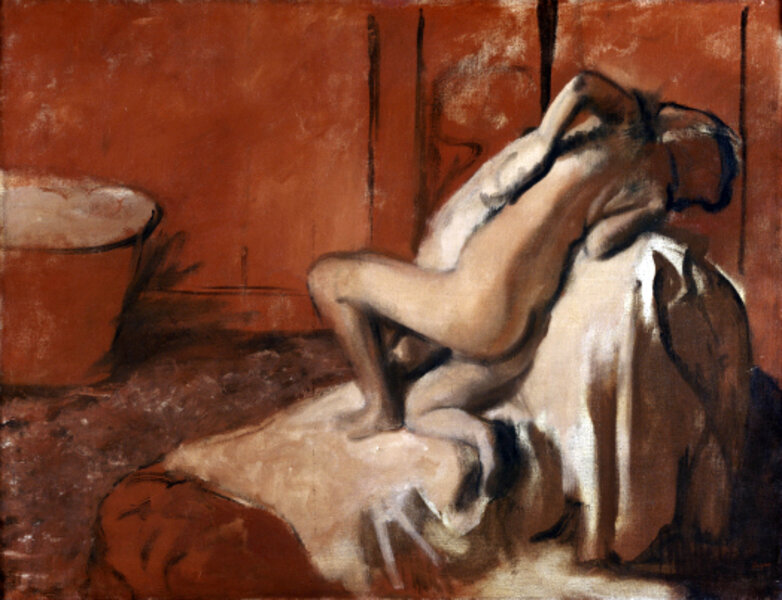'Degas and the Nude' reveals a master of the human form
Loading...
The nude human figure has been the subject of artists for thousands of years. Their work is sometimes erotic, sometimes beautiful or ugly, and sometimes uncomfortable, as its subject is being literally "laid bare."
"Degas and the Nude," a major exhibition opening at Boston's Museum of Fine Arts (MFA) Oct. 9, offers the most comprehensive look ever at the nudes of French artist Edgar Degas (1834-1917), know principally for his depictions of ballet dancers and race track scenes.
But Degas also had a lifelong interest in the nude human form, taking a special interest in showing contemporary women bathing or grooming. "Degas is the master of the nude in the 19th century," declares George Shackelford, the MFA's chair of the art of Europe and curator of modern art, who is also co-curator of the exhibition.
While nudes were a frequent subject for Degas, he took a specific approach. "Degas was an omniscient viewer, looking into the nudes' private world where poses were both natural and acrobatic," explains the exhibition's wall text. "Degas almost never showed his bathers except from behind. Perhaps he did not want to show their faces, to create identifiable individuals.... Maybe he wanted viewers to understand the figures as bodies engaged in daily tasks common to everyone – combing their hair, washing, drying their bodies."
Of the approximately 165 works, 145 are by Degas himself, created over more than 50 years. They show his skill in a wide variety of media, including paintings, pastels, drawings, monotypes, etchings, lithographs, and sculptures. Many of the works can be seen in the United States for the first time.
To put Degas in perspective, the exhibition also includes 20 works by some contemporaries and those who would follow, such as Jean Auguste Dominique Ingres, Eugéne Delacroix, Mary Cassatt, Gustave Caillebotte, Pierre-Auguste Renoir, Henri de Toulouse-Lautrec, Henri Matisse, and Pablo Picasso.
The exhibition was conceived by Mr. Shackelford along with Xavier Rey, curator of paintings at the Musée d'Orsay in Paris, which holds the world's largest collection of Degas nudes. The Musée d'Orsay contributed 60 works to the exhibition, the most from a single source. Other contributors include the National Gallery in London, the Metropolitan Museum of Art in New York, the Art Institute of Chicago, and the Philadelphia Museum of Art, along with other museums and private collections.
The works offer neither a simple commentary on the role of the nude in art nor a simple insight into the thinking of Degas.
"Degas's art is, like his habits of mind, complex and contradictory, resisting either easy interpretation or precise definition," Shackelford writes in his curator's statement. "Degas's nudes reveal the complexity of his humanity, his wonder at the world outside his own body expressed through his representation of another body. His models' nakedness is, in the end, his own."
An early work, "Scene of War in the Middle Ages" (1863-65), for example, features nine female nude figures in various poses on a medieval battlefield dominated by male soldiers. The painting could have been a commentary on the American Civil War then underway, Shackelford surmises, or simply a general comment on men's inhumanity toward women during times of war. The female figures' prostration and nudity, in contrast to the armored males on horseback, emphasizes their vulnerability.
In a Degas sculpture, a nude woman examines her raised foot while perched precariously on the other. The position is complex, unusual, and contorted. Is she a dancer or a bather inspecting her foot? Why? We don't know.
A series of monotypes, not intended by Degas for public exhibition, depicts scenes in Paris brothels, some of which are sexually explicit. But even here, the intent may not have been so much to titillate as to comment on the world of the brothel and its role in 19th-century Parisian society, including issues of sanitation, health, morality, and social class.
Boston is the only US venue for "Degas and the Nude." The exhibition runs through Feb. 5. It will reopen at the Musée d'Orsay in Paris (March 12 to July 1, 2012).





